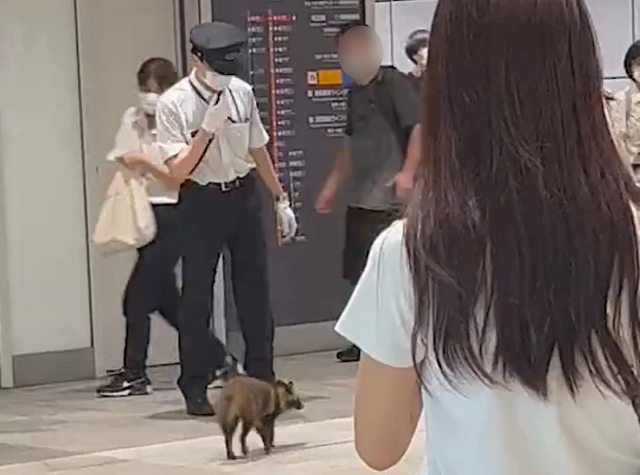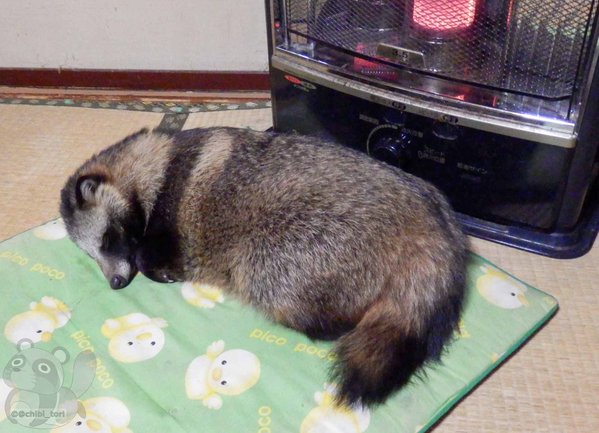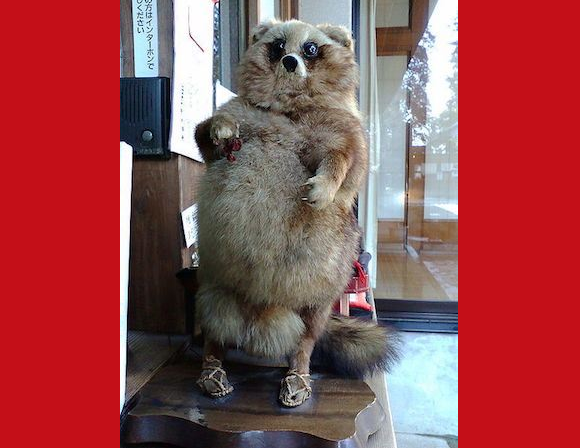Our northern Kanto reporters team up and head to Gunma for a look at this part of Japan that gets overlooked by tourists.
Tanuki
Wild animal’s surprise appearance makes people wonder if this was a shapeshifting salaryman on his way home from work.
Japanese raccoon dogs are known for their large…ahem, appendages. But which one is the largest of them all?
Because nothing says “delicious cooking” like huge, saggy pig balls, right?
The people have made it clear that they want the shrine to stay, but will that be enough to save it?
They may look similar at first glance, but the two separate species of forest critters have a handful of key differences.
See this tanuki? Aren’t his balls cute? Welcome to Japan, where raccoon-dog genitals are universally admired.
During these crisp, cool days of autumn, the leaves are changing color to vibrant reds and yellows. Along with that change in the scenery comes a shift in fashion, as people step out in sweaters, coats, and other cold-weather attire.
But while you or I can put on a heavy jacket to help ward off the chill, that’s not an option for Japan’s woodland animals. Don’t worry, though because while these tanuki can’t put on additional layers of clothing to keep warm, they can add additional layers of tanuki by sleeping in an adorable bunch.
Japanese raccoon dogs, or tanuki as they’re known over here, are animals with great significance in Japanese folk-lore. Among their many supernatural attributes such as giant scrota and swift speeds, the tanuki are also known for their purported shapeshifting abilities.
And though the above picture clearly dispels the size of their manhood, there appears to be some truth to their art of disguise. As the Twitter user who posted the photo explains, this little guy is actually pretending to be a stray cat so he can get some of the food laid out for him.
Tanuki, also known as Japanese raccoon dogs, hold a special place in Japanese culture. Often the center of folktales for their large testicles, magical abilities, and easygoing attitude, you can see them depicted in works of art all over the country.
However, now the tanuki is threatened. Not the actual animal, but a cake created in its image known as the tanuki cake. For many middle-aged Japanese people the mention of such a treat would awaken fond childhood memories. Despite this, the tanuki cake population in Japan has plummeted in recent years to the point of being critically endangered.
That’s why the website Tanuki Cake No Aru Toko Meguri has established the National Tanuki Cake Habitat Map, so that we may monitor and perhaps conserve these noble animal-shaped cakes.

















 7-Eleven Japan’s ramen-cooking robot whipped us up a bowl of noodles【Taste test】
7-Eleven Japan’s ramen-cooking robot whipped us up a bowl of noodles【Taste test】 Hello Kitty Choco Egg figures are an adorable trip through three periods of Japanese pop culture【Pics】
Hello Kitty Choco Egg figures are an adorable trip through three periods of Japanese pop culture【Pics】 Disillusionment at Tsukiji’s tourist-target prices led us to a great ramen restaurant in Tokyo
Disillusionment at Tsukiji’s tourist-target prices led us to a great ramen restaurant in Tokyo Cyberpunk anime meets traditional culture in Ghost in the Shell gold leaf Japanese changing screens
Cyberpunk anime meets traditional culture in Ghost in the Shell gold leaf Japanese changing screens Should you warm up your convenience store onigiri rice balls in the microwave?【Taste test】
Should you warm up your convenience store onigiri rice balls in the microwave?【Taste test】 Is the all-you-can-eat KFC buffet in Tokyo really as good as they say it is?
Is the all-you-can-eat KFC buffet in Tokyo really as good as they say it is? Lacquerware supplier to emperor of Japan and Pokémon team up for new tableware
Lacquerware supplier to emperor of Japan and Pokémon team up for new tableware Japanese company will turn a photo of a deceased relative into a 3D rendering that’s also an urn
Japanese company will turn a photo of a deceased relative into a 3D rendering that’s also an urn Studio Ghibli umbrellas bring anime joy to Japan’s rainy season
Studio Ghibli umbrellas bring anime joy to Japan’s rainy season Princesses, fruits, and blacksmiths: Study reveals the 30 most unusual family names in Japan
Princesses, fruits, and blacksmiths: Study reveals the 30 most unusual family names in Japan Japan may add Japanese language proficiency, lifestyle classes to permanent foreign resident requirements
Japan may add Japanese language proficiency, lifestyle classes to permanent foreign resident requirements Starbucks Japan releases new zodiac chilled cup drink for 2026
Starbucks Japan releases new zodiac chilled cup drink for 2026 7-Eleven Japan starts new temporary luggage storage service in over 300 branches
7-Eleven Japan starts new temporary luggage storage service in over 300 branches Starbucks on a Shinkansen bullet train platform: 6 tips for using the automated store in Japan
Starbucks on a Shinkansen bullet train platform: 6 tips for using the automated store in Japan Large amount of supposed human organs left in Osaka marketplace
Large amount of supposed human organs left in Osaka marketplace Japan’s otoshidama tradition of giving kids money at New Year’s gets a social welfare upgrade
Japan’s otoshidama tradition of giving kids money at New Year’s gets a social welfare upgrade A Japanese dating app matched our bachelorette with a Buddhist monk, and she learned some things
A Japanese dating app matched our bachelorette with a Buddhist monk, and she learned some things Japan’s human washing machines will go on sale to general public, demos to be held in Tokyo
Japan’s human washing machines will go on sale to general public, demos to be held in Tokyo Japanese train company is letting fans buy its actual ticket gates for their homes
Japanese train company is letting fans buy its actual ticket gates for their homes Starbucks teams up with 166-year-old Kyoto doll maker for Year of the Horse decorations【Photos】
Starbucks teams up with 166-year-old Kyoto doll maker for Year of the Horse decorations【Photos】 Tokyo considering law requiring more trash cans following litter increase in heavily touristed area
Tokyo considering law requiring more trash cans following litter increase in heavily touristed area Tokyo’s Tsukiji sushi neighborhood asks tour groups to stay away for the rest of the month
Tokyo’s Tsukiji sushi neighborhood asks tour groups to stay away for the rest of the month Nintendo’s Kirby now delivering orders at Kura Sushi restaurants, but not in Japan
Nintendo’s Kirby now delivering orders at Kura Sushi restaurants, but not in Japan Tokyo event lets you travel back in time, for free, to celebrate 100 years since Showa era start
Tokyo event lets you travel back in time, for free, to celebrate 100 years since Showa era start Sanrio theme park in Japan announces plans to expand into a Sanrio resort
Sanrio theme park in Japan announces plans to expand into a Sanrio resort Survey asks foreign tourists what bothered them in Japan, more than half gave same answer
Survey asks foreign tourists what bothered them in Japan, more than half gave same answer Japan’s deadliest food claims more victims, but why do people keep eating it for New Year’s?
Japan’s deadliest food claims more victims, but why do people keep eating it for New Year’s? We deeply regret going into this tunnel on our walk in the mountains of Japan
We deeply regret going into this tunnel on our walk in the mountains of Japan Studio Ghibli releases Kodama forest spirits from Princess Mononoke to light up your home
Studio Ghibli releases Kodama forest spirits from Princess Mononoke to light up your home Major Japanese hotel chain says reservations via overseas booking sites may not be valid
Major Japanese hotel chain says reservations via overseas booking sites may not be valid Put sesame oil in your coffee? Japanese maker says it’s the best way to start your day【Taste test】
Put sesame oil in your coffee? Japanese maker says it’s the best way to start your day【Taste test】 The top 10 annoying foreign tourist behaviors on trains, as chosen by Japanese people【Survey】
The top 10 annoying foreign tourist behaviors on trains, as chosen by Japanese people【Survey】 No more using real katana for tourism activities, Japan’s National Police Agency says
No more using real katana for tourism activities, Japan’s National Police Agency says Starbucks Japan reveals new sakura drinkware collection, inspired by evening cherry blossoms
Starbucks Japan reveals new sakura drinkware collection, inspired by evening cherry blossoms Is the all-you-can-eat KFC buffet in Tokyo really as good as they say it is?
Is the all-you-can-eat KFC buffet in Tokyo really as good as they say it is? Lacquerware supplier to emperor of Japan and Pokémon team up for new tableware
Lacquerware supplier to emperor of Japan and Pokémon team up for new tableware Japanese company will turn a photo of a deceased relative into a 3D rendering that’s also an urn
Japanese company will turn a photo of a deceased relative into a 3D rendering that’s also an urn Studio Ghibli umbrellas bring anime joy to Japan’s rainy season
Studio Ghibli umbrellas bring anime joy to Japan’s rainy season Princesses, fruits, and blacksmiths: Study reveals the 30 most unusual family names in Japan
Princesses, fruits, and blacksmiths: Study reveals the 30 most unusual family names in Japan Can a dirty butthole make you filthy rich in Japan? We’re starting a New Year’s lottery experiment
Can a dirty butthole make you filthy rich in Japan? We’re starting a New Year’s lottery experiment Dungeons & Dragons Pokémon fanart inspires incredible cosplay group
Dungeons & Dragons Pokémon fanart inspires incredible cosplay group Japan’s number-one cosplayer Enako reveals shocking amount she earns from manga gravure modeling
Japan’s number-one cosplayer Enako reveals shocking amount she earns from manga gravure modeling Which Japanese convenience store sells the best onigiri rice balls?【Taste test】
Which Japanese convenience store sells the best onigiri rice balls?【Taste test】 Studio Ghibli releases new anime calendars for 2026 with heartwarming fan service
Studio Ghibli releases new anime calendars for 2026 with heartwarming fan service All-you-can-eat lunch buffet for just 850 yen right next to Shinjuku Station
All-you-can-eat lunch buffet for just 850 yen right next to Shinjuku Station Shonen Jump surprises readers with literal booby traps in new online manga service
Shonen Jump surprises readers with literal booby traps in new online manga service